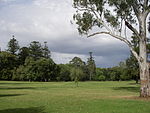Adelaide Zoo

Adelaide Zoo is Australia's second oldest zoo (after Melbourne Zoo), and it is operated on a non-profit basis. It is located in the parklands just north of the city centre of Adelaide, South Australia. It is administered by the Royal Zoological Society of South Australia Incorporated (trading as Zoos South Australia or Zoos SA), which is a full institutional member of the Zoo and Aquarium Association (ZAA) and the World Association of Zoos and Aquariums (WAZA), and which also administers the Monarto Safari Park near Murray Bridge.The zoo houses about 300 native and exotic species, with over 3,000 animals on site. The zoo's most recent enclosures are in the second phase of the South-East Asia exhibit, known as Immersion, providing visitors with the experience of walking through the jungle, with Sumatran tigers and orangutans seemingly within reach. Five buildings within the zoo have been listed as state heritage places on the South Australian Heritage Register, including the front entrance on Frome Road and the former Elephant House. The zoo is also a botanical garden and the grounds contain significant exotic and native flora, including a Moreton Bay fig planted in 1877. The giant panda exhibit, which opened in December 2009, is home to two giant pandas, Wang Wang and Funi, which will remain at the zoo until at least 2024.
Excerpt from the Wikipedia article Adelaide Zoo (License: CC BY-SA 3.0, Authors, Images).Adelaide Zoo
Frome Road, Adelaide Adelaide
Geographical coordinates (GPS) Address Phone number Website External links Nearby Places Show on map
Geographical coordinates (GPS)
| Latitude | Longitude |
|---|---|
| N -34.914166666667 ° | E 138.60583333333 ° |
Address
Adelaide Zoo
Frome Road
5000 Adelaide, Adelaide
South Australia, Australia
Open on Google Maps






